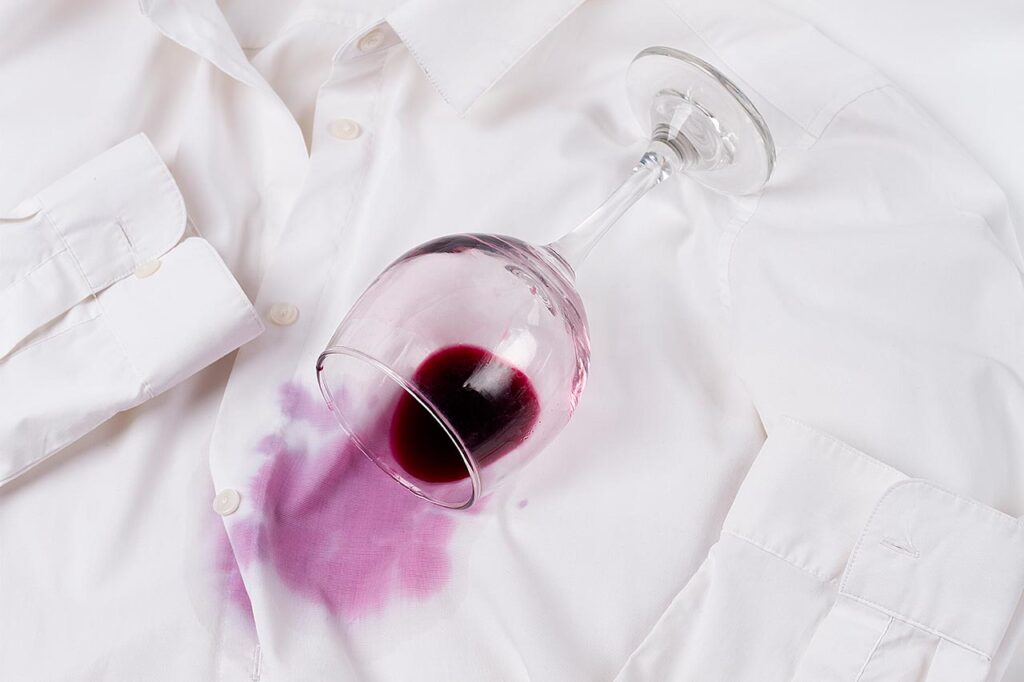The Secret to Stain Removal
When you drip some red white on your white silk blouse, what do you do next? To begin with, always check the care label. But sometimes that’s not enough when you’re talking about a favorite piece of your wardrobe.
Here’s the best advice I can give about removing stains from clothing yourself at home.

The first step in most every circumstance is to remove the excess spill immediately.
- Soak up any excess liquid spill by gently blotting (not rubbing) – on both sides of the garment if possible
- For thick spills like salad dressing, use a spoon to gently remove the excess
Your next step might be to use a commercial stain removal product. Or maybe you’ll just toss it in the washer and dryer. But do these steps work for all stains and all fabrics? Absolutely NOT!
Check the care label.
Maybe using a clean, wet towel would help. Maybe not. It all depends on the type of spill, the fibers, and even the weave of the fabric. For example, terry cloth can take more aggressive handling than a cotton shirt or blouse. And a cotton shirt can take more scrubbing than a silk wedding gown. Can silk or acetate be cleaned with water (don’t try it)? What about viscose (yes to water)? There are alternative treatments using solvents, water, vacuum, steam, and more.
Using a commercial stain removal product for a protein stain like blood is applied differently on wool than on acetate or polyester. There’s chemistry involved. Hopefully the instructions on the commercial product are detailed enough to work successfully for you. If not, either the stain remains or you remove color from the fabric around the stain, which typically permanently damages the garment.
But here’s how you can successfully remove more stains in three EASY steps:
- Spend a couple of years studying textiles and chemistry and learn under the guidance of a trained and experienced textile specialist.
- You’ll need some tools of the trade like –
- a spotting board with vacuum (helps pull a chemical agent through the garment),
brushes (for tamping or tapping stain removal products to penetrate and break up the spot), - a spatula (to help work the out stain), towels (to absorb cleaning agents and water from the garment and absorb the stain as it is washed through the garment),
- cheesecloth (for absorbing and for wrapping brushes used on delicate garments),
- tweezers (to hold small samples of fabric when identifying fabrics),
- eyedroppers (to apply small amounts of stain removal agents to stain),
- litmus and pH paper (to test and make sure all of the stain removal agents have been successfully removed from and to test the acidity and alkalinity of the stained area).
- a spotting board with vacuum (helps pull a chemical agent through the garment),
- Take the time (if you have it) to apply your knowledge and tools to save your garment – and accept the fact that every spot cannot be removed. This is often the case when someone has tried to remove the stain with the wrong agent or when the garment has been washed and placed in a dryer without the stain being removed. This can cause the stain to set, sometimes making further recovery to be unsuccessful.
The BEST way to remove stains in the Birmingham area is to bring it to our experienced textile specialists as soon as possible. Always remove the excess spill first. And then leave the rest of the work to the pros. You’ll save time, energy, and have a better chance of getting your garment back in the condition it was before the stain.
Some dry cleaners, especially the low priced cleaners, do not work on stain removal beyond cleaning the garment.
Please understand that even the most trained and experienced technicians cannot remove every stain. But the good ones will try and they will be successful more often than not.
One more bit of advice. When you bring in your clothes (or send them in if you use our dry cleaning and laundry pickup and delivery service), be sure to let us know about any stains and what procedures or products you have applied.
Your clothes will last longer if you follow this advice – “Leave it to the PROS.”

